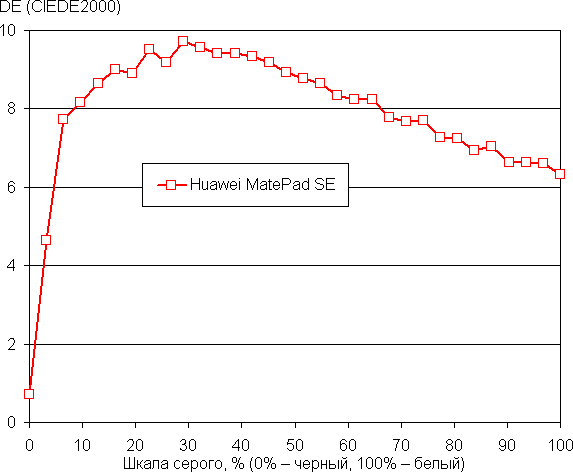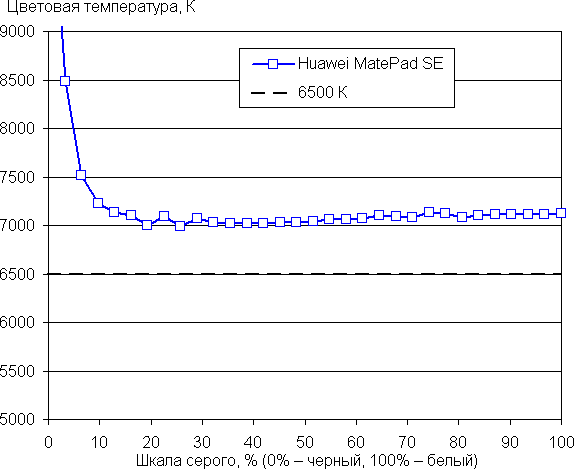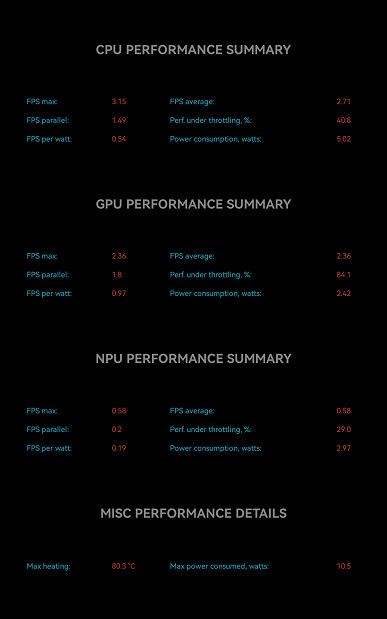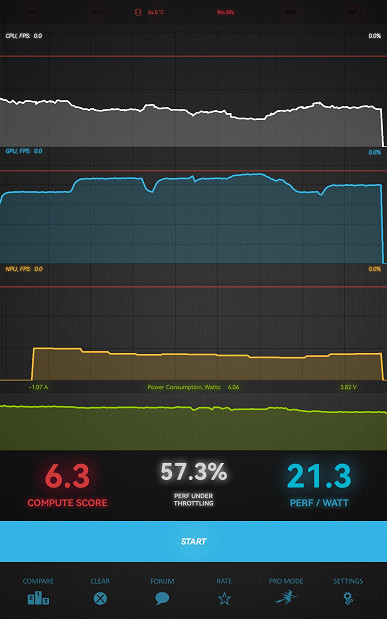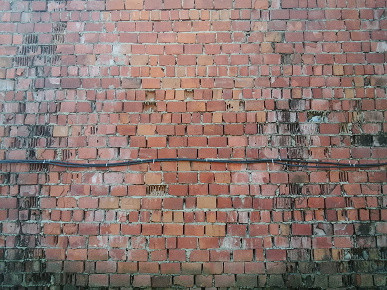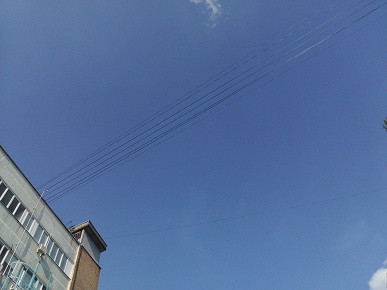In addition to flagship devices and models with unique technologies, our readers are interested in budget solutions from famous brands. After all, it’s one thing to please geeks, and another to offer practical and economical devices for everyday use. Huawei MatePad SE 11" is an example of an affordable tablet that, at least at first glance, does not look like a budget device. Let's see what it can do!
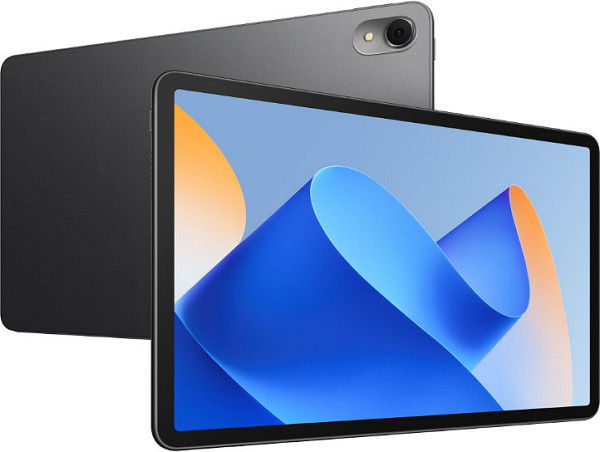
The model is available in four variants. The first, the most budget-friendly ($180), is equipped with 4 GB of RAM. The second variant is similar to the first, but comes with a children's case and a special OS shell. The third variant offers 6 GB of RAM, and the fourth — 8 GB of RAM and a stylus in the kit, the cost of which is $250. Some stores offer discounts at the start of sales. The flash drive capacity for all models is 128 GB.
Now let's look at other characteristics of the device and compare them with the MatePad 11 «2023 and MatePad 2022.
Technical specifications
| Huawei MatePad SE 11″ (2024) | Huawei MatePad 11″ (2023) | Huawei MatePad (2022) | |
|---|---|---|---|
| Screen | IPS, 11″, 1920×1200 (207 ppi) | IPS, 11″, 2560×1600 (274 ppi) with a refresh rate of 120 Hz | IPS, 10.4″, 2000×1200 (224 ppi) |
| SoC (processor) | Huawei Kirin 710A (8 cores, 4+4, max frequency 2.4 GHz) | Qualcomm Snapdragon 865 (8 cores, 1+3+4, maximum frequency 2.84 GHz) | Huawei Kirin 710A (8 cores, 4+4, max frequency 2 GHz) |
| RAM | 4/6/8 GB | 6 GB | 4 GB |
| Flash memory | 128 GB | 128 GB | 64/128 GB |
| Memory card support | No | No | microSD, up to 512 GB |
| Connectors | USB 2.0 (USB-C connector) with support for external storage devices, provided external power is supplied | USB 2.0 (USB-C connector) with support for external storage | USB 2.0 (USB-C connector) with support for external storage |
| Cameras | front (5 MP, 720p video) and rear (8 MP, 1080p 30 fps video shooting) | front (8 MP, 1080p video) and rear (13 MP, 4K 30 fps video shooting) | front (8 MP, 1080p video) and rear (13 MP, 1080p 60 fps video shooting) |
| Internet | Wi-Fi 5 (MIMO, 2.4 + 5 GHz) | Wi-Fi 6 (MIMO, 2.4 + 5 GHz) | Wi-Fi 5 (MIMO, 2.4 + 5 GHz), optional 3G/4G |
| Authorization | face recognition | face recognition | face recognition |
| Keyboard Cover/Stylus Support | no / yes | there is / there are | there is / there are |
| operating system | Huawei HarmonyOS 2 | Huawei HarmonyOS 3.1 | Huawei HarmonyOS 2 |
| Battery | 7700 mAh | 7250 mAh | 7250 mAh |
| Dimensions | 252×164×6.9 mm | 254×165×7.2 mm | 245×155×7.3 mm |
| Weight of the non-LTE version | 475 g | 480 g | 450 g |
Overall, the 2024 model is inferior in characteristics to the “full-fledged” last year’s MatePad 11″. You can see that it is slightly thinner, having a more capacious battery. Let’s see how this affects the battery life.
Packaging, equipment and accessories
The tablet came to us in a box with a design that is quite typical for Huawei products. Interestingly, the stylus was also inside, and not in a separate box.
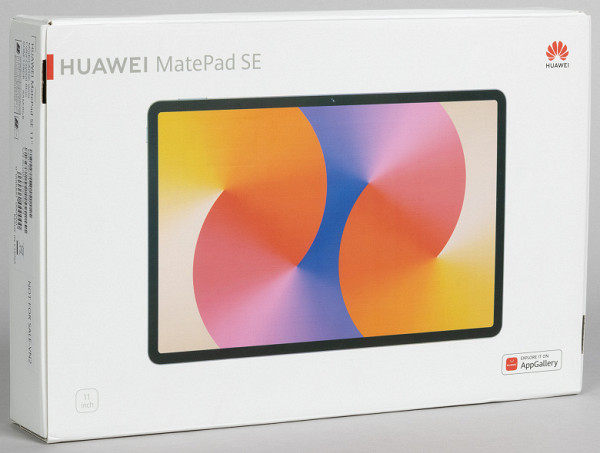
This is what the complete set looks like.
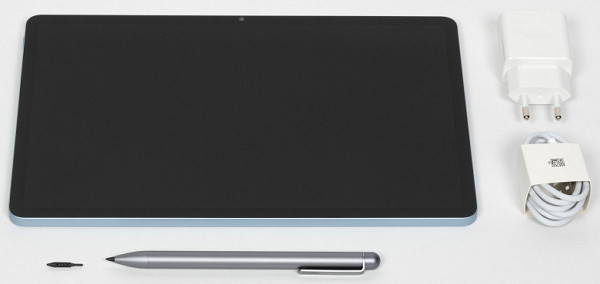
What we see here is a stylus with a replaceable tip, a USB-A to USB-C cable, and a 5V 2A charger with support for fast charging at 9V 2A or 10V 2.25A (22.5W).
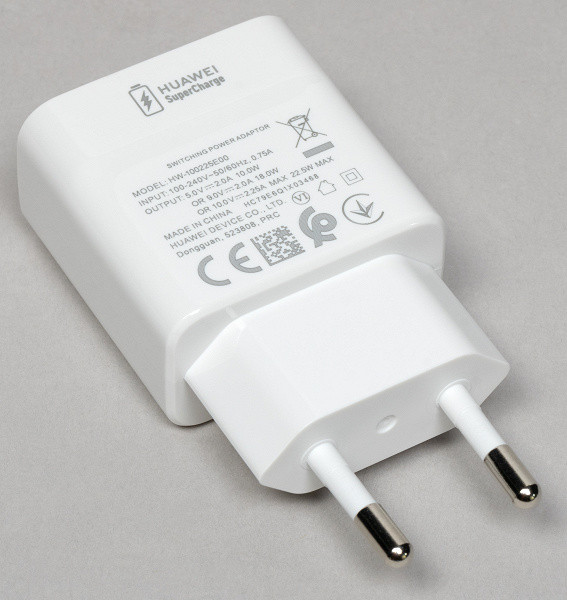
More expensive Huawei tablets come with a more powerful charger, but that's not bad either.
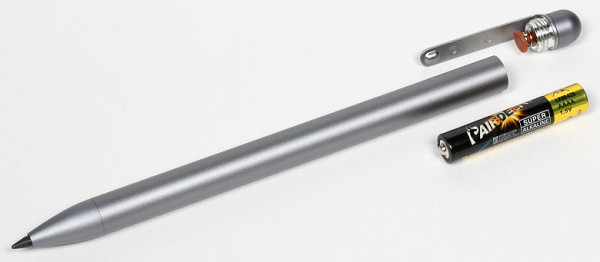
The stylus that comes with the tablet is the M-Pen Lite, a simpler version of the M-Pen 2. It runs on a AAA battery and has no additional controls. However, it does have a clip, like a ballpoint pen, which is quite convenient since there are no stylus mounts or magnets on the tablet.
Design
The appearance of the tablet itself is traditional and does not give away its low cost. It has a solid metal case with a very small thickness (6.9 mm) and a narrow frame around the display (7 mm).
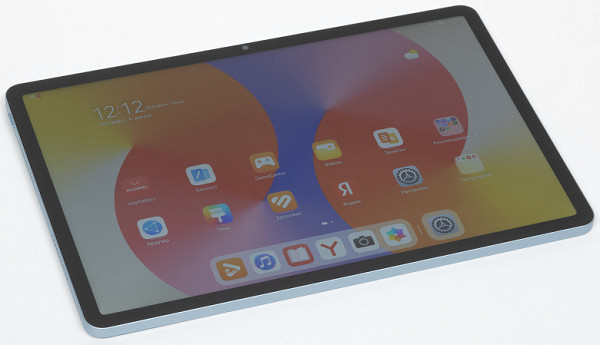
There are no elements on the front surface except for the camera for video communication and facial recognition. The camera is located exactly in the center of the long side.
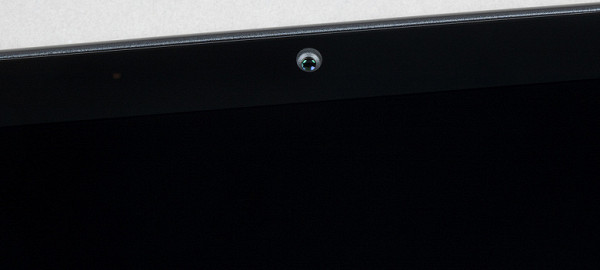
The back panel has the Huawei logo in the center (it might look more aesthetically pleasing if it were engraved, but here it’s just paint) and a camera module in the corner. Despite the elongated shape, there’s only one camera in the module, so most of the element is purely decorative.
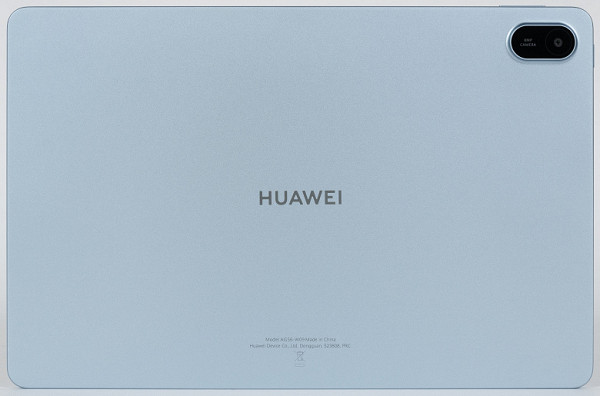
It's worth noting that the tablet's color in the photos doesn't always convey its true appearance. At first glance, it looks simply silver (metallic), but upon closer inspection, a barely noticeable bluish tint appears. This tone, although less noticeable than in our studio shots, adds a special appeal to the device.
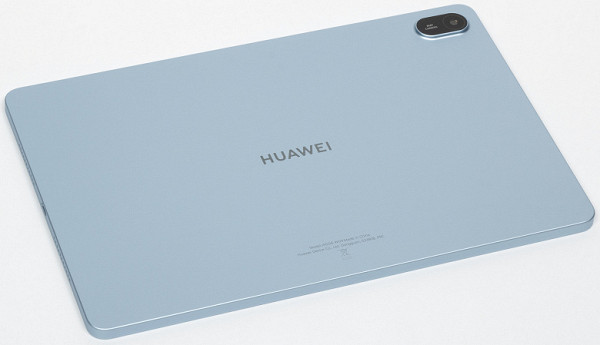
The sides are flat, but with rounded transitions on them, so that the sharp edges do not dig into the palm.
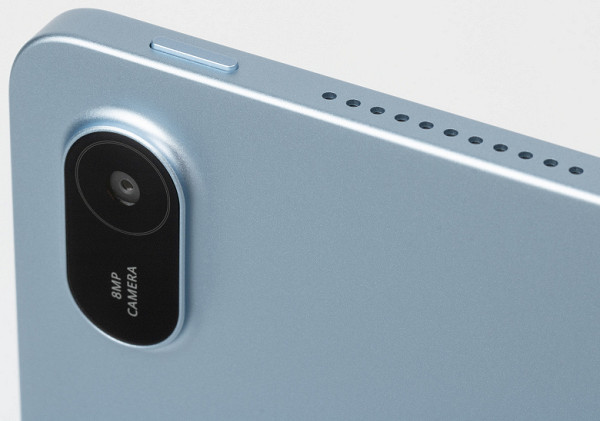
The controls are traditionally placed: the power button is on the top left edge (if you hold the tablet with the screen facing you in landscape mode), and the long volume rocker is on the top left edge. We note that such close placement may be inconvenient for users, especially at first, since the buttons feel very similar to the touch. However, over time you get used to it, and manufacturers probably have their own reasons for this design.
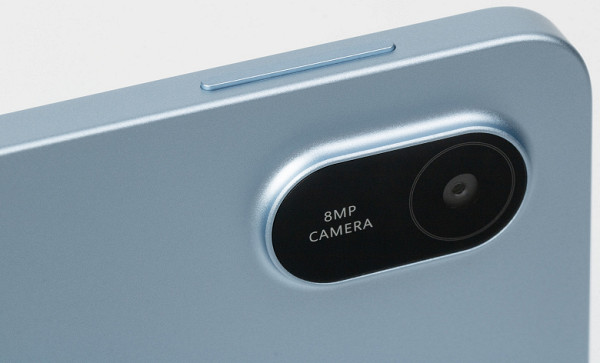
Stereo speakers are located on the short side edges.

On the right side there is a USB-C connector, which is used to connect a charger and external drives. However, there is an important nuance: if you connect a regular flash drive via a USB-A to USB-C adapter (or a flash drive with USB-C), the tablet will not recognize it. To work with the drive, external power is required, so you need a hub or a special adapter. Thus, the USB OTG capabilities are not fully realized, although the tablet still detects drives with their own power. This is a noticeable drawback, since most other devices from this manufacturer do not have problems with flash drives — they work directly without additional accessories.

It is worth noting that the tablet does not have slots for installing memory cards and SIM cards. There is also no jack for a wired headset, which has already become commonplace. In addition, the tablet is not equipped with a keyboard connector, so you will have to use a wireless connection via Bluetooth.

Overall, the design is very decent for a budget device, and the nuances listed can probably be tolerated.
Screen
The tablet's 11-inch display with a resolution of 1920×1200 provides an average density of 207 ppi. However, the quality of the screen depends not only on these figures, so we tested it using our own method.
The screen is covered with a glass panel with a mirror-smooth surface that is resistant to scratches. Anti-glare properties are better than those of the Google Nexus 7 (2013), and the doubling of reflected objects is minimal, which speaks of OGS (One Glass Solution) technology. This reduces the number of borders between the screen layers and improves visibility in bright sunlight. The surface of the screen has an oleophobic coating that effectively repels fat, making it easier to remove fingerprints.
When testing a white field, the maximum brightness was 430 cd/m², which, although not ideal, given the anti-glare properties, makes the screen readable in the sun. The minimum brightness is 2 cd/m², which allows you to comfortably use the tablet in the dark. The device also supports automatic brightness control. In automatic mode, the brightness changes depending on the lighting conditions: in the dark — up to 4 cd/m², in office lighting — up to 160 cd/m², and in bright sunlight — up to a maximum of 430 cd/m². We increased the brightness in the dark to 20 cd/m² for better comfort, and the auto-brightness function generally proved its adequacy. At all brightness levels, there is no significant modulation of the backlight, which eliminates screen flickering.
The tablet matrix is IPS, and microphotographs show the characteristic subpixel structure for this type.
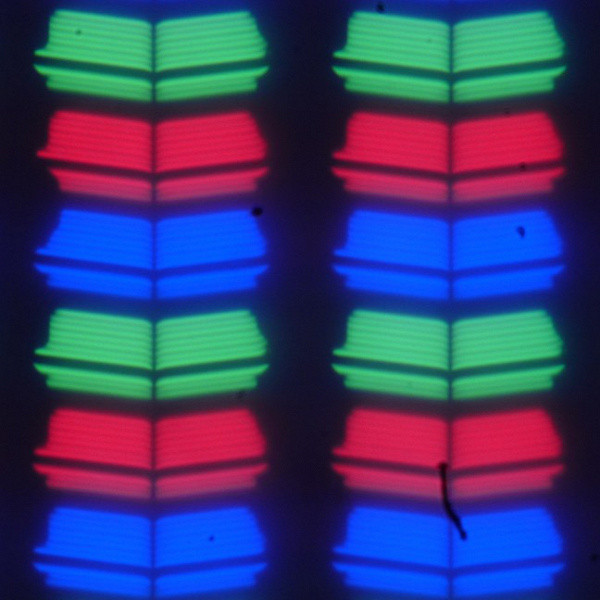
Let's imagine photos where the screens of this tablet and the Nexus 7 (above) show the same images. The brightness of both screens is initially set to about 200 cd/m², and the color balance on the camera is set to 6500 K.
The images have a white field perpendicular to the screens:
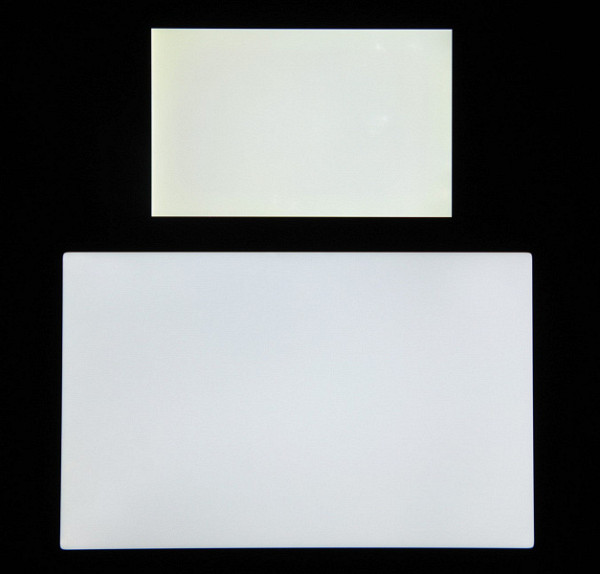
Note the good uniformity of brightness and color tone of the white field.
And the test image:

The colours on the screen of the tested tablet have a saturation close to natural, and the colour balance of the screens is clearly different.
When viewed from a perpendicular angle, the uniformity of the black field is average:
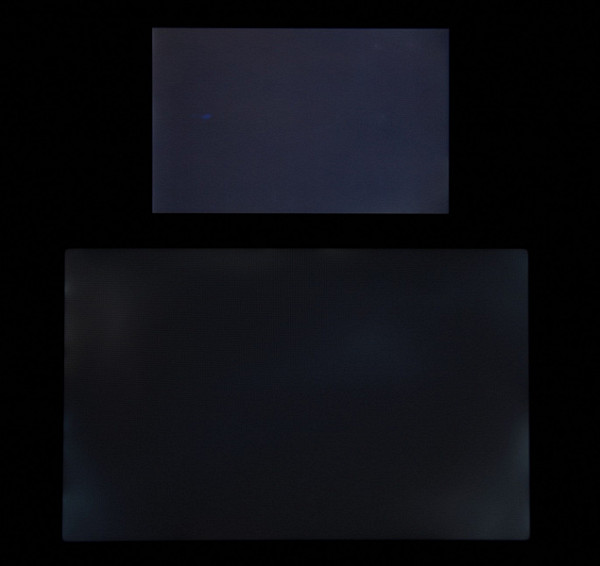
The screen of this tablet provides good viewing angles, maintaining color rendition even with significant deviations of the gaze. At the same time, the black field noticeably brightens with a diagonal deviation, while remaining conditionally neutral gray.
The screen contrast is about 1600: 1. The response time when switching between black and white is 15 ms (8 ms when turned on and 7 ms when turned off). The transition between shades of gray of 25% and 75% takes 28 ms.
The gamma curve, constructed using 32 points with an equal interval of shades of gray, showed no dips in either highlights or shadows. The parameter of the approximating power function was 2.06, which is slightly lower than the standard value of 2.2. The real gamma curve is close to a power dependence:
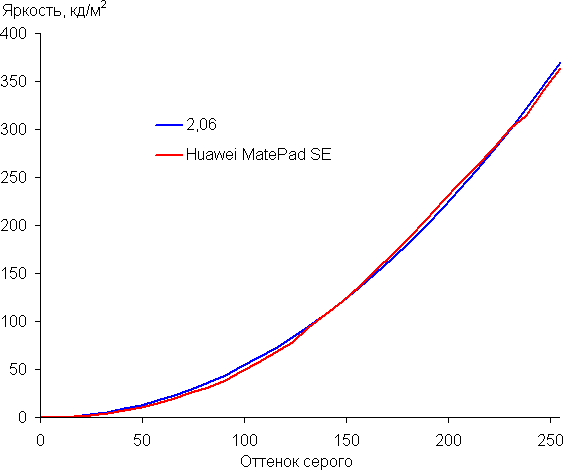
We did not find any dynamic adjustment of the backlight brightness in accordance with the nature of the displayed image, which is very good.
The color gamut is close to sRGB:
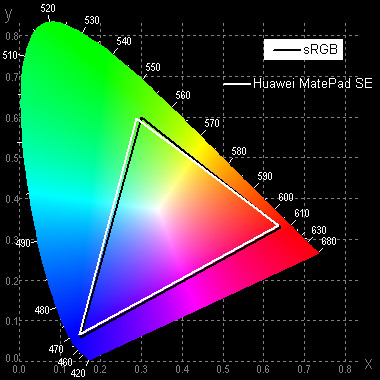
The spectra show that the matrix filters mix the components with each other to a moderate degree:
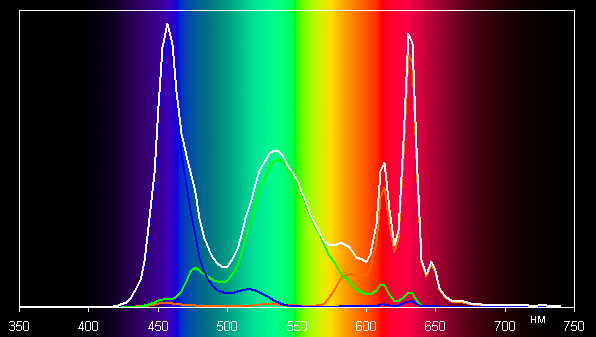
By default, the color temperature of the white field is about 7600K, which is a bit high. However, this device provides the ability to adjust the color balance by adjusting the hue on the color wheel or choosing one of three preset profiles.
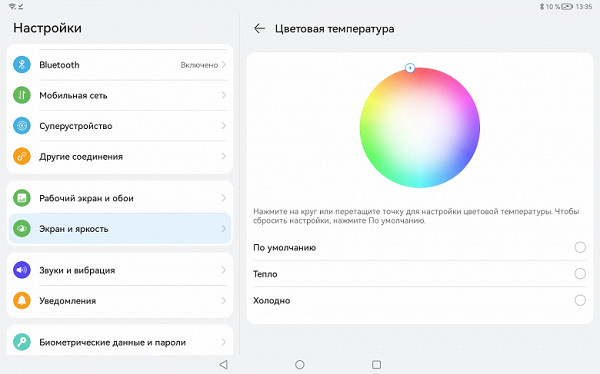
After manual correction (as in the picture above), it was possible to bring the color temperature closer to the standard 6500 K and keep the deviation from the spectrum of the absolute black body (ΔE) below 10. The color temperature and ΔE remain stable when changing the shade of gray, which has a positive effect on the perception of the color balance. However, the correction range was insufficient — a point on the edge of the circle. (Dark areas of the gray scale can be ignored, since the color balance in them is not so important, and the measurement error at low brightness is large.)
However, there is no particular point in doing the correction.
There is already a traditional setting that allows you to reduce the intensity of the blue component.
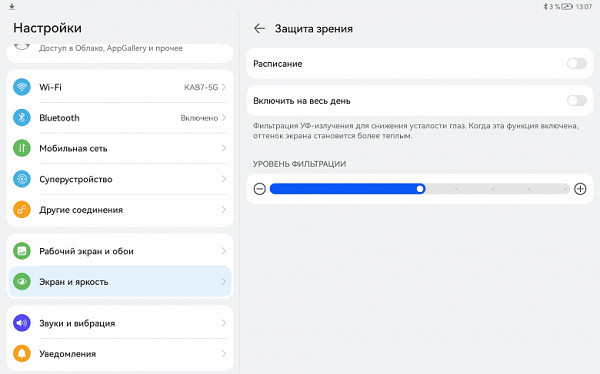
Of course, there is no eye fatigue caused by blue light or UV radiation. Bright light can disrupt circadian rhythms (see the article about the iPad Pro with a 9.7-inch display), but this is easily solved by reducing the brightness to a comfortable level. There is no point in distorting the color balance by reducing the proportion of blue.
Apparently, the device does not support DisplayPort Alt Mode for USB Type-C, which limits the output of image and sound to external devices.
As a result, the screen has a low maximum brightness (up to 430 cd / m²), but excellent anti-glare properties, which allows you to use it outdoors even in sunny weather. In the dark, the brightness can be reduced to a comfortable 2 cd / m². Automatic brightness control works adequately. The advantages of the screen are an effective oleophobic coating, no air gap and flickering, high contrast (1600: 1), sRGB color gamut and acceptable color balance (especially after correction). The disadvantages include low black stability when looking away. However, given the requirements for this class of devices, the screen quality can be considered high.
Performance
The MatePad SE 11″ runs on the Huawei Kirin 710A platform, which is a budget SoC that is an update of the Kirin 710 and is manufactured at SMIC factories in China. It includes eight cores: four Cortex-A73 and four Cortex-A53. Although the officially declared frequencies of the updated version are slightly lower, in this case the maximum frequency of the performance cores reaches 2.4 GHz — perhaps this is either a semi-official overclocking or the result of increasing the frequencies during the production process. The Mali-G51 is responsible for the graphics part, and the amount of RAM in the older model that we tested is 8 GB.
Now let's move on to browser tests: Octane Benchmark, Kraken Benchmark and JetStream 2.
| Huawei MatePad SE 11″ (2024) (Kirin 710A) | Huawei MatePad 11″ (2023) (Qualcomm Snapdragon 865) | Huawei MatePad (2022) (Kirin 710A) | |
|---|---|---|---|
| Octane 2.0 (points, more is better) | 9490 | 23912 | 9074 |
| Kraken Benchmark 1.1 (ms, lower is better) | 3920 | 1851 | 4526 |
| JetStream 2 (points, more is better) | 33 | 54 | 29 |
So, when working in the browser, the situation is generally clear: the MatePad 2022 is a little behind, but the MatePad 11″ (2023) is far ahead of the review hero.
Next come the comprehensive benchmarks Geekbench and AnTuTu.
| Huawei MatePad SE 11″ (2024) (Kirin 710A) | Huawei MatePad 11″ (2023) (Qualcomm Snapdragon 865) | Huawei MatePad (2022) (Kirin 710A) | |
|---|---|---|---|
| Geekbench 5 / 6 Single-Core Score (points, higher is better) | 301 / 320 | 886 / — | 300 / — |
| Geekbench 5/6 Multi-Core Score (scores, higher is better) | 1342 / 937 | 2789 / — | 1336 / — |
| Geekbench 5 / 6 Compute (scores, higher is better) | 1063 / 495 (unreliable result) | 3077 / — | 992 / — |
| AnTuTu Benchmark v9 / v10 (scores, more is better) | 226590 (unreliable result) / 191445 | 767707 / — | 184256 / — |
An AnTuTu situation needs some clarification. We first tested the tablet in AnTuTu v9, as the other devices were tested in it. However, the app repeatedly said: “This score is incorrect” (even though the numbers looked quite reasonable). Then we tested the MatePad SE in AnTuTu v10, and this time everything went fine, but the result was lower: 191445 (with the note “managed to beat 1% of users”). However, the overall picture is clear. In addition, in the Compute subtest of Geekbench 6, we received the message “One or more workloads have failed validation and have been assigned a score of zero”, so we marked the result as unreliable.
Now let's move on to the GPU tests. First, let's test in 3DMark.
| Huawei MatePad 11″ (2024) (Kirin 710A) | Huawei MatePad 11″ (2023) (Qualcomm Snapdragon 865) | Huawei MatePad (2022) (Kirin 710A) | |
|---|---|---|---|
| 3DMark (Sling Shot Extreme mode) | 1092 | Max | 1082 |
| 3DMark (WildLife mode) | 554 | 3809 | 565 |
And GFXBenchmark. Here, however, we should note that we did not test the MatePad 2022 in this benchmark — it did not work correctly. That's why it is not in the table.
| Huawei MatePad 11″ (2024) (Kirin 710A) | Huawei MatePad 11″ (2023) (Qualcomm Snapdragon 865) | |
|---|---|---|
| GFXBenchmark 1440р Aztec Ruins (High Tier Offscreen) | 2.9 fps | 20 fps |
| GFXBenchmark 1080p Aztec Ruins (Normal Tier Offscreen) | 7.6 fps | 53 fps |
| GFXBenchmark 1080p Car Chase Offscreen | 8.5 fps | 52 fps |
| GFXBenchmark 1440p Manhattan 3.1.1 Offscreen | 7.9 fps | 50 fps |
| GFXBenchmark 1080p Manhattan 3.1 Offscreen | 15 fps | 87 fps |
| GFXBenchmark 1080p Manhattan Offscreen | 21 fps | 125 fps |
So, we have found the weakest point of the tablet — its performance. In normal everyday use (web surfing, email, etc.) this probably won't be a big problem, especially considering the decent amount of RAM for tablets. However, it won't be exceptionally smooth and instantly responsive to your actions, and there's no point in talking about gaming capabilities.
Operating system and communication
The tablet runs HarmonyOS 2.0, which is not the latest version anymore — Huawei's flagships use 4.2. However, the difference in functionality between these major releases is not that significant, so the average user will not miss out on much. It is important to note that this tablet will most likely not receive significant OS updates.
However, the basic functions of HarmonyOS 2.0 are quite satisfactory. Users can install Android apps from AppGallery, which also provides a search for third-party repositories, such as APKPure, or download APK files without problems.
However, Google apps and related services will not work without additional tools. There are solutions such as GSpace and GBox that imitate support for Google services. GBox even installs automatically if you try to download something «Google» from AppGallery. However, it is worth noting that this does not solve all the problems, since GBox only supports a limited number of applications.
Among the advantages of AppGallery in the current conditions, we can highlight the availability of applications from Russian banks that were removed from the Play Market, as well as support for Russian Mir payment cards.
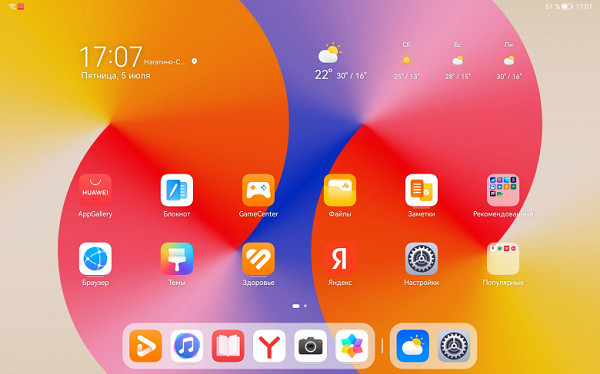
We have already looked at the capabilities and features of this version of HarmonyOS in detail, so we will not go into details.
As for communication, the maximum speed here is limited to the Wi-Fi 5 standard, which is the norm for budget tablets. There is also no LTE module and support for satellite navigation, which does not allow using the device as a navigator in a car.
Autonomous operation and charging
| Huawei MatePad SE 11″ (2024) (Kirin 710) | Huawei MatePad 11″ (2023) (Qualcomm Snapdragon 865) | Huawei MatePad (2022) (Kirin 710A) | |
|---|---|---|---|
| 3D gaming, battery benchmark GFXBenchmark Manhattan (brightness 100 cd/m²) | 9 hours 6 minutes | 5 hours 55 minutes | 6 hours 22 minutes |
| Watching online videos from YouTube (brightness 100 cd/m²) | about 12 hours | 13 hours 20 minutes | 13 hours 10 minutes |
| Reading mode, white background (brightness 100 cd/m²) | 14 hours 10 minutes | 22 hours 25 minutes | 17 hours 25 minutes |
The tablet is equipped with a non-removable 7700 mAh battery, which is a good indicator for this segment, especially considering its thickness. However, the results of the battery life tests raise questions. In gaming mode (GFXBench battery test), the hero of the review lasted much longer than the selected competitors, although its performance is lower than that of the Snapdragon 865, so the comparison with the Huawei MatePad 11 "(2023) looks logical. But the reason why it so significantly outperformed the Huawei MatePad (2022) remains unclear. In other tests, the results are more expected: the Snapdragon 865 demonstrates greater energy efficiency, and the older tablet is inferior, probably due to SoC overclocking.
We conduct a test for performance degradation with heating using the Burnout Benchmark program, which loads the CPU, GPU and NPU.
| Load on | Heating performance, as a percentage of maximum |
|---|---|
| CPU | 41% |
| GPU | 84% |
| NPU | 29% |
The decrease in performance when heated is average.
The tablet supports relatively fast charging; it charges from the included power supply in just over two hours.
Camera
The MatePad has one rear camera with a resolution of 8 MP, capable of shooting video in Full HD at 30 fps. There is no flash.
The quality of the photos is pleasantly surprising: although the resolution is low, this is even beneficial. Of course, this is still a budget level, but the photos are quite decent, and you can view them in full size without embarrassment.
The situation with video is much less favorable. The picture strobes and jerks, the focus constantly changes, and the dynamic range is very narrow. In general, you can use this tablet for shooting video only in extreme cases. A sample video is available at the link (36.4 MB).
As for the front camera, there are no complaints about its quality, although the resolution is only 5 MP. It is quite suitable for video calls.
Conclusions
Huawei MatePad SE 11″ (2024) is an affordable tablet designed primarily for reading on the go, browsing social networks and web surfing (with Wi-Fi or a smartphone with Internet distribution). Its main advantages include a stylish design, compact size, average quality IPS screen and stereo speakers, as well as a reasonable price. The older version comes with a stylus. However, to achieve this balance, we had to make some compromises. The device’s performance is low, although it is quite sufficient for everyday tasks. There is no mobile Internet and satellite navigation, there is no support for memory cards, and connecting drives to USB is only possible through a hub with its own power supply. The cameras correspond to the budget segment, and are especially disappointing in video shooting. It is also worth noting that the tablet runs on HarmonyOS 2.0, and not the more current 4.2. If these limitations do not bother you, then Huawei MatePad SE 11″ can be a good choice.

